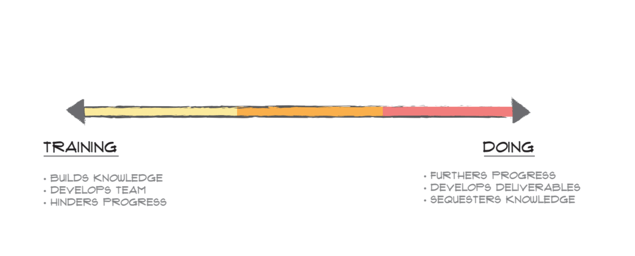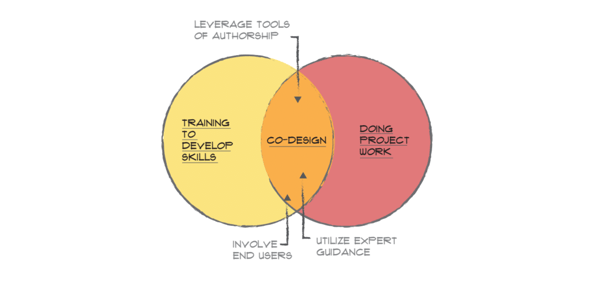We’ve all been there. You’re sent away for an expensive week of training and while some of what you learned was helpful, you find it hard to apply your new knowledge.
“What was that fourth step? How do I frame the problem statement again?”
Even more, you come back to a thousand emails and a project list that hasn’t changed since you left. Then, in 6 months when you actually need to apply what you learned, you forgot what taught and the instructor is no longer around for questions.
On the other hand, think about the last time you worked with an outside agency to do a project. Let’s take, for example, a service design project that utilizes design thinking. Even if the contracted agency did a great job, what you’re left with when it’s over is often just a deliverable. It was probably detailed, well written and insightful. But… what do you do with it? We often are stuck with questions.
“How do I pull this forward? How can our team use the report to complete the work we are held accountable for? Where did these insights come from?”
Often we wish our teams had worked with the outside vendor more closely so they really understood how the agency came to the conclusions they did.
Does there have to be a tradeoff between training and real work outcomes?
Do these situations sound familiar? On one hand, classroom training leaves us swamped. On the other an out-of-context deliverable leaves us clueless.
Many people believe that this is just the way the world works—in order to develop the knowledge of our teams we have to sacrifice our productivity, and to increase our productivity, we have to sacrifice the development of our teams.

But what if we could bring together the benefits of training and project work? Could we benefit from them simultaneously? Does there have to be a tradeoff?
The answer lies in training-by-doing
As designers, we usually don’t take either/or situations at face value. We don’t believe in the training vs. doing dichotomy. We take a ‘yes-and’ approach to problems—questioning if the perceived limitations are in-fact real.
How can we both train teams and have them do real work?
It turns out, you can have the best of both efforts. Getting training doesn’t have to exclude doing project work. In fact, when you combine both training and doing, you often get better work done faster and help your team retain actionable knowledge they can re-apply to other projects.
When it comes to training-by-doing, leveraging the knowledge of an outside expert can help facilitate and accelerate this process. For example, an outside agency can work with you to execute a pressing project that your team might not have done before.
The expert trains your team in new methods, bringing in relevant knowledge, tools and examples to facilitate learning that is then directly applied to the project.
The most essential part of this process is collaboration. Training-by-doing is not just simply tacking on project work to the end of a lecture or having teams fill out a questionnaire. To get the benefits of both training and doing, your team and agency partner need to adopt a new mindset and approach to collaboration.
How co-design enables training-by-doing
Co-design is an approach to research, strategy and design that opens up the development process to users and other ‘non-expert’ groups. Agencies that practice co-design don’t just do work for you, but do work with you. This is the foundation of training-by-doing.
Co-design provides clarity and visibility to an otherwise opaque process. It facilitates training for those involved—allowing teams to work alongside each other on projects and learn new skills along the way. It is a process enabled by specific way of thinking, methods and tools. Although it can often be messy, the ability to make together creates shared meaning and understanding that helps people learn in ways traditional approaches can’t. It builds gut-level understanding through experience.

Here are some tips when thinking about getting started with co-design for training by doing:
Adopt Co-Design as a Mindset
Everyone is creative and experts of their own experiences. They can learn and contribute knowledge as collaborators.
The Lessons Are In The Tools
Having the right tools enables much more effective collaboration. For example, Maketools is a method pioneered by Liz Sanders. The design of learning is often baked into the design of the tools themselves.
Set Dates with Destiny
With no constraints, teams often generate a lot of ideas or talk too much—but co-design is about making things and moving forward. Setting time constraints or dates with destiny, like presentations to leaders or customers, can be useful in accelerating the process.
Involve End Users
If you are getting trained in user empathy make sure you give the team experience talking to actual customers. Making with customers is even better!
Create Moments of Reflection
To help synthesize learning of the process, ask team members to reflect from time to time about what they’ve learned and how it can apply to other projects. This approach helps solidify knowledge into long term memory.
Different Models of training-by-doing
Designing a training-by-doing program can be challenging as it is often hard to shake off the traditional approach to training and/or project work. Below are three models of how to go about it—ranging from an intensive apprenticeship to a slight ‘flipping’ of the way traditional classrooms are held.
The Team Apprenticeship Model
In days long ago most people became professionals by way of apprenticeship— developing new skills and perspectives as they actually did work under the watchful eye of a master.
While our formal educational system no longer leans on this approach, it is a model that really fits well with teams tackling inherently holistic/complex projects like service design or digital transformation.
In the apprenticeship model, participants hone skills from the masters while getting it done in the trenches. They not only learn as individuals, but the collective knowledge of the team grows so that they are equipped to carry out a similar approach on other projects. This model is best used when teams have a big problem and are motivated to solve it.
Great examples include the design thinkers’ academy in Amsterdam and P&G’s model for their Clay Street Innovation studio (although P&G has shifted to more of a ‘workshop acceleration’ approach in recent years to matchup with organizational realities).
Workshop Acceleration Model
Given the pace of change in today’s environment and the popularity of design thinking and service design, a new ‘hyper-accelerated’ training-by-doing approach has evolved.
These accelerated workshops often involve short, 1-3 week ‘sprints’ for teams to quickly apply a design process to solve a very specific problem. The process is often very structured to help teams explore a specific customer need, trend, technology or feature set. This helps build momentum, energy and acceleration for the team. It’s often not recommended for foundational insights or more involved strategic processes, as the quick hit approach can leave some stones unturned.
Google Ventures is famous for their design sprint process and it has been a popular tool for many in the technology space.
The Flipped Classroom Model
To help innovation teams increase their chance of success, companies usually train them on new processes and capabilities during specific stages in the development process.
These capabilities are usually created by experts who fly around the company, give lectures about the process, answer a few questions and then hand out instruction manuals to teams. The teams are often left to figure things out for themselves.
‘Flipping the classroom’ is an approach to education that was popularized by the Khan Academy. Its aim is to make in-person time more impactful by assigning ‘flipped’ lessons as pre-work to the classroom.
Source image: Washington.edu
When used for corporate projects, ‘flipping training’ enables employees to learn about a new process or capability before they meet with the expert, leaving time for short training-by-doing workshops. These ½ to 3 day sessions help teams accelerate a specific phase of their project and are often applied ‘on-demand’ whenever a team reaches a certain phase.
Training-by-doing for service design
At Stratos we work with many innovation and experience teams to help them develop a deep understanding of their customers and stakeholders across each step of their journey. We often use service design methods to unearth these strategic insights. We’ve found that a major part of the value we bring teams goes beyond the final deliverable.
Involving teams in the co-design process really helps them understand where the insights came from. It brings a deeper level of empathy and understanding for the people they serve—giving them hands on experience with the day-to-day challenges their customers face.
We practice co-design because we believe it is the best approach to gaining deep insights, while knowing that training and knowledge transfer are the beneficial side-effect. But after so many powerful experiences with clients where we’ve been able to enable their entire teams, we realized that we could take it a step beyond.
So recently we’ve developed a series of offerings to formalize the ‘learning-by-doing’ approach into our service design projects. This helps our clients not only get more actionable outputs from the project, but slowly develops a service design capability in their teams and champions across their organization.
The future of corporate learning and development?
We believe that this approach to learning could be the future for corporate training and development. With so many well-designed training resources available online, traditional models are losing relevance. Less than 1/4 of learning and development professionals are willing to recommend their own L&D programs to their peers. While many tactical skills will be learned via YouTube and Coursera, how will teams learn about more holistic subjects like service design?
We think there a big need to make co-design the go-to approach for learning complex subjects around innovation, customer research, process improvement, branding, new product development, systems thinking, organizational design and strategic foresight. New types of partnerships will form between agencies and internal teams as the relationships shift from transactional to reciprocatory.
Because let’s face it—none of us want to end up coming home from a week of lectures with 2,000 unread emails and 5 research deliverables we don’t know what to do with. Life is stressful enough already.
* If you’re looking to grow your team's codesign capabilities through journey mapping,
 “The Complete Guide to Co-creating Journey Maps with Your Customers”
“The Complete Guide to Co-creating Journey Maps with Your Customers”

